 , 张千千2
, 张千千2

1. 河北省农业区划办公室, 石家庄 050000;
2. 中国地质科学院水文地质环境地质研究所, 石家庄 050061
收稿日期: 2020-06-18; 修回日期: 2020-07-30; 录用日期: 2020-07-30
基金项目: 城市与区域生态国家重点实验室开放基金(No.SKLURE2019-2-3);国家自然科学基金资助项目(No.41401593)
作者简介: 缪丽萍(1983-), 女, 高级工程师, E-mail: 156494841@qq.com
通讯作者(责任作者): 张千千, E-mail: z_qqian@163.com
摘要:2016年4月—2017年10月对93场降雨事件绿色屋面径流、沥青屋面径流和干湿沉降进行采样分析,运用多元统计方法,基于径流水质浓度和污染负荷两种角度,重点揭示绿色屋面径流水质的源汇特征,识别绿色屋面对降雨径流的滞留能力及影响因素,探讨了绿色屋面径流的污染来源.结果表明:绿色屋面具有很好的径流滞留效果,平均径流滞留率达到53.4%.绿色屋面径流滞留率月变化受到降雨量的显著影响,表现为在丰水期7、8和10月径流滞留率(73.6%、80.9%和93.6%)小于枯水期4、5、11和12月滞留率(100%).绿色屋面径流滞留率与降雨量和降雨历时表现出显著的负相关关系,与雨前干期相关性较弱.基于径流水质,绿色屋面显著增加了径流中EC、COD、TOC、K+、Ca2+、Cl-和SO42-的浓度,是它们的污染源,但显著降低了径流中NH4+-N和Zn的浓度,是它们的汇;基于污染负荷,绿色屋面仅是K+、Cl-和SO42-的污染源,是NH4+-N和Zn的汇.绿色屋面存在4类污染源,即有机物和重金属源(来自于泥炭土和沥青油毡)、离子污染源(来自于泥炭土和蛭石)、物化污染源和营养物质污染源(来自于泥炭土和大气沉降).研究结果可为绿色屋面的科学设计,管理和控制城市暴雨径流提供科学依据.
关键词:绿色屋面径流水质主成分分析污染源
Characteristics of source and sink of runoff in green roof and the pollutant source analysis
MIAO Liping1
 , ZHANG Qianqian2
, ZHANG Qianqian2

1. Agriculture Regional Planning Officer of Hebei Province, Shijiazhuang 050000;
2. Institute of Hydrogeology and Environmental Geology, Chinese Academy of Geological Sciences, Shijiazhuang 050061
Received 18 June 2020; received in revised from 30 July 2020; accepted 30 July 2020
Abstract: 93 rainfall event samples (from April, 2016 to October, 2017) from the runoff of green roof and asphalt roof,and the dry and the wet deposition were measured and analyzed. Based on the runoff water quality and pollution load,the characteristics of source and sink of green roof runoff were revealed,the retention capacity of green roof to rainfall runoff and its influencing factors were identified,the pollution source of green roof runoff was discussed by using multivariate statistical analysis. The results showed that the green roof effectively retained rainfall runoff,with a mean retention rate of 53.4%. The monthly variation of the green roof runoff retention was obviously affected by rainfall volume. The retention rates of green roof runoff in July,August and October (the retention rates were 73.6%,80.9% and 93.6%,respectively) was less than that in April,May,November and December (the retention rates in the four month was 100%). There was a significant negative relationship between runoff retention and rainfall volume and rainfall duration (p < 0.001). However,the runoff retention capacity of green roof was not significantly affected by the antecedent dry weather period. Compared the runoff water quality of the green roof,control roof and the dry and the wet deposition,it was found that the green roof significantly reduced the concentration of NH4+-N and Zn,while,it significantly increased the concentration of EC,COD,TOC,K+,Ca2+,Cl- and SO42-. Based on the pollutants loads in different samples,we found that the green roof was a sink for NH4+-N and Zn,while it was a source for K+,Cl- and SO42-. Four potential pollution sources to green roof runoff were apportioned by using principal component analysis: organic and metal sources (from peat soil and asphalt felt),ion sources (from peat soil and vermiculite),physicochemical sources,and nutrient pollution sources (from peat soil and atmospheric deposition). These results provide a scientific basis for the design and application of green roofs to manage and control urban storm runoff.
Keywords: green roofrunoffwater qualityprincipal component analysispollution source
1 引言(Introduction)绿色屋面也称之为生态屋面, 是指在现有建筑物和城墙的顶部种植植物, 是城市区域内一种特殊的地表覆盖类型, 也是一种控制城市面源污染的新型措施(Berndtsson et al., 2009).绿色屋面通常可以分为两种类型:集约型绿色屋面和粗放型绿色屋面.集约型绿色屋面具有较厚的土壤层(大于15 cm), 能够种植较大的植物(乔木和灌木树种), 可以作为一个屋顶花园;而粗放型绿色屋面具有较薄的土壤层(小于15 cm), 仅能种植草本或小型植物.
近年来, 绿色屋面已经在美国、德国、日本等发达国家得到广泛的推广和应用(Vijayaraghavan et al., 2012;Todorov et al., 2018).先前研究发现绿色屋面具有多重生态效益, 如减少城市热岛效应(Razzaghmanesh et al., 2016; Skala et al., 2020), 减少城市内涝(Zhang et al., 2015), 改善空气质量(Hao et al., 2010; Song et al., 2019), 增加生物多样性(Benvenuti et al., 2014), 减少噪声污染等(Connelly et al., 2013).
近年来, ****开始关注绿色屋面调控径流水文过程的能力及降雨径流水质特征.研究者发现绿色屋面基质和植物可以吸附和吸收部分雨水, 能够有效地消减暴雨径流的径流量(王书敏等, 2011; Nawaz et al., 2015; Cipolla et al., 2016), 能够延缓径流产生时间和消减洪峰流量(Hathaway et al., 2015; Carpenter et al., 2016).但关于绿色屋面如何影响径流水质存在争议.绿色屋面能够通过吸收、转化和过滤等作用降低径流中污染物的浓度, 但也可能导致污染物从基质层释放到径流中(Harper et al., 2015).研究者普遍发现:绿色屋面可以中和暴雨径流的pH (Aithenhead et al., 2011; Chen, 2013), 但是绿色屋面释放了大量的N、P等营养物质和金属离子进入径流(张千千等, 2015;Dusza et al., 2017; Wang et al., 2017;Gong et al., 2020).绿色屋面对径流水质的影响并未达成共识, 有些****也发现绿色屋面减少径流中N的浓度(Seidl et al., 2013), 降低了径流中PO43-的浓度(Speak et al., 2014)等.造成上述争议的原因主要是研究者所选择绿色屋面基质组分、植物种类、径流监测时间、以及各地的空气质量等诸多因素存在差异的缘故(Alsup et al., 2016).
本研究组建粗放式的绿色屋面, 在对其径流水质和水文过程开展长期监测(93场次降雨事件)的基础上, 运用多元统计技术, 从径流水质浓度和污染负荷两种角度分析, 重点揭示绿色屋面径流水质的源汇特征, 识别绿色屋面对降雨径流滞留能力及影响因素, 探讨了绿色屋面径流的污染来源, 以期为绿色屋面的科学组建和城市面源污染的有效控制提供科学依据.
2 材料与方法(Materials and methods)2.1 绿色屋面与沥青屋面结构与设计绿色屋面和沥青屋面组建于2016年3月, 位于中国地质科学院水文地质环境地质研究所办公楼楼顶.绿色屋面和沥青屋面各组建了3个1 m2(长×宽=1 m×1 m)的小型屋面(图 1), 距离地面50 cm, 屋面四周安装了50 cm高的不锈钢板作为围挡, 用于防止雨水飞溅.屋面出水口为直径2 cm的不锈钢管, 外接30 cm长的塑料管直接连接雨水收集箱, 屋面材质为不锈钢材质.
图 1(Fig. 1)
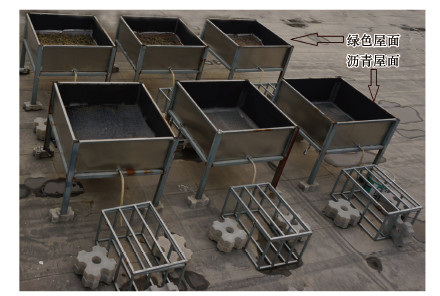 |
| 图 1 绿色屋面和沥青屋面组建图 Fig. 1Building diagram of green roof and asphalt roof |
绿色屋面的结构选用国际通用的模式, 从上而下分为5层, 依次是植物层、基质层、过滤层、排水层和防水层.植物层种植的是佛甲草(Sedum lineare Thunb).基质层选择了一种轻质的商业基质(泥炭土、珍珠岩、蛭石、锯末), 并在其中加入生物炭(净水型椰壳生物炭)用于吸附径流中的污染物, 各基质的体积比为2∶3∶3∶0.5∶1, 基质层的厚度为10 cm, 基质理化性质见表 1.过滤层选用规格为100 g·m-2的聚酯纤维无纺布.排水层选用的是新型块状塑料排水板, 其规格为33.3 cm×33.3 cm×2.0 cm(长×宽×高).防水层是在不锈钢屋面的基础上铺设一层改性沥青油毡用于防止雨水渗漏.沥青屋面是在不锈钢屋面的基础上铺设一层改性沥青油毡, 与绿色屋面做对比研究.
表 1(Table 1)
| 表 1 绿色屋面基质的理化特点 Table 1 Several physico-chemical properties of the substrates | |||||||||||||||||||||||||
表 1 绿色屋面基质的理化特点 Table 1 Several physico-chemical properties of the substrates
| |||||||||||||||||||||||||
2.2 样品采集与分析屋面径流和干湿沉降样品采集于2016年4月29日—2017年10月30日, 共观测93场降雨事件, 降雨特征统计详见表 2. 在本研究中, 降雨间隔大于6 h, 定义作为1场降雨事件, 为满足测试需求, 仅对降雨量大于0.2 mm的降雨事件进行了监测和统计.
表 2(Table 2)
| 表 2 降雨特征统计表 Table 2 The characteristics of rain events | ||||||||||||||||||||||||||||||||||||
表 2 降雨特征统计表 Table 2 The characteristics of rain events
| ||||||||||||||||||||||||||||||||||||
屋面径流样品采集:降雨前将径流收集箱用纯水洗净, 并与屋面相连, 将径流收集器密封好, 降雨停止后, 屋面不产流时采集径流样品, 同时测定屋面径流的体积.
干湿沉降样品采集:上次采集降雨后, 将采样箱洗净, 放于屋面上, 待下次降雨结束时, 立即收集样品.
测试指标主要有pH、EC、TN、NH4+-N、NO3--N、TP、COD、TSS、TOC、Cl-、SO42-、K+、Ca2+、Fe和Zn.pH和EC分析使用美国Hach (HQ40D)便携式多参数水质分析仪;其它水质指标均按照《水和废水监测分析方法》(2002)的要求执行.
2.3 数据分析本研究中运用非参数的Kruskall-Wallis和Mann-Whitney U检验方法, 分析绿色屋面、沥青屋面和干湿沉降样品中各污染物浓度和污染负荷的显著差异性.使用回归分析(CA)探讨绿色屋面径流滞留能力与降雨特征之间的相关性.运用主成分分析(PCA)识别绿色屋面径流的主要污染来源.
3 结果和分析(Results and discussion)3.1 绿色屋面降雨径流滞留特点通过分析93场不同降雨强度的降雨事件发现(表 3), 绿色屋面的径流量(528.1 mm)要明显小于沥青屋面(1102.8 mm).绿色屋面的滞留率为9.8%~100%, 平均径流滞留率达到53.4%.沥青屋面的滞留率为0~52.8%, 平均滞留率仅为2.70%. 绿色屋面的径流滞留率显著高于沥青屋面, 说明绿色屋面具有很好的截流效果.
表 3(Table 3)
| 表 3 绿色屋面和沥青屋面的径流滞留率统计表 Table 3 The rainfall runoff retention rate for the green and the asphalt roof | ||||||||||||||||||||||||
表 3 绿色屋面和沥青屋面的径流滞留率统计表 Table 3 The rainfall runoff retention rate for the green and the asphalt roof
| ||||||||||||||||||||||||
绿色屋面径流滞留率月变化表现出, 在7、8和10月降雨量大的月份, 其径流滞留率较低, 分别为73.6%、80.9%和93.6%(图 2).然而在降雨量小的月份, 如4、5、11和12月, 绿色屋面径流滞留率较高, 均为100%, 说明绿色屋面径流滞留率受到降雨量的显著影响.
图 2(Fig. 2)
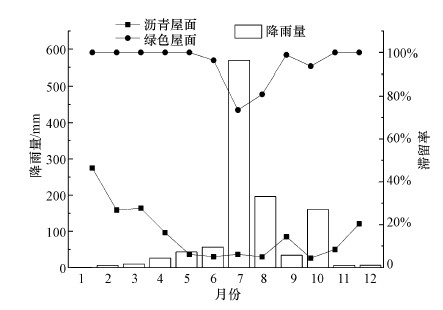 |
| 图 2 绿色屋面和沥青屋面径流滞留率的月变化 Fig. 2The monthly variation of runoff retention rate for the green and the asphalt roof |
3.2 绿色屋面降雨径流水质特征3.2.1 绿色屋面降雨径流中pH、EC和TSS的特点绿色屋面径流pH均值为7.13, 与沥青屋面径流均值7.21和干湿沉降均值6.95无显著性差异(图 3a), 且均满足国家地表水的标准(6.0~9.0)(GB3838-2002).绿色屋面径流EC的均值为357.2 μS·cm-1, 要显著的高于沥青屋面68.5 μS·cm-1和干湿沉降53.2 μS·cm-1(图 3b).说明绿色屋面基质释放了大量的离子进入径流, 是EC的源.由图 3c可以看出, 绿色屋面TSS的浓度均值为23.2 mg·L-1, 高于干湿沉降中TSS的浓度16.4 mg·L-1, 但是低于沥青屋面TSS的均值33.6 mg·L-1, 说明绿色屋面可以适当减少屋面径流中TSS.
图 3(Fig. 3)
 |
| 图 3 绿色屋面、沥青屋面和干湿沉降中pH(a), EC (b) and TSS (c)的平均浓度 Fig. 3The average pH(a), EC (b) and TSS (c)concentrations of monitoring rainfall events from the green roof, the asphalt roof, and the rainfall |
3.2.2 绿色屋面降雨径流中营养物质(N和P)和有机污染物(COD和TOC)的特点沥青屋面TP的平均浓度(0.295 mg·L-1)要略高于绿色屋面(0.256 mg·L-1) (图 4a), 二者TP的平均浓度要明显高于干湿沉降(0.039 mg·L-1), 但未表现出显著差异性.与沥青屋面相比, 绿色屋面TP的浓度略低, 说明绿色屋面吸附了径流中的部分P.但绿色屋面和沥青屋面径流中TP的浓度均高于国家地表水的Ⅲ类水质标准(0.2 mg·L-1)(GB3838—2002).
图 4(Fig. 4)
 |
| 图 4 绿色屋面、沥青屋面和干湿沉降采样中TP(a)、TN, NO3--N和NH4+-N(b)、COD和TOC(c)的平均浓度 Fig. 4The average concentrations of TP (a), TN, NO3--N and NH4+-N (b), COD and TOC (c) of monitoring rainfall events from the green and the asphalt roof, and the rainfall |
绿色屋面径流中TN和NO3--N的平均浓度(8.27 mg·L-1和3.68 mg·L-1)要高于沥青屋面(5.97 mg·L-1和1.35 mg·L-1)和干湿沉降(5.63 mg·L-1和1.43 mg·L-1) (图 4b).尽管绿色屋面径流中TN和NO3--N的浓度与沥青屋面和降雨无显著性差异, 但绿色屋面径流中TN的浓度超过国家地表水的Ⅲ类水质标准(1.0 mg·L-1)(GB3838—2002).绿色屋面径流中NH4+-N的浓度均值(1.55 mg·L-1)要显著低于沥青屋面(4.35 mg·L-1)和干湿沉降(4.04 mg·L-1).在沥青屋面径流和干湿沉降中NH4+-N的浓度均超出了国家地表水的Ⅴ类水质标准(2.0 mg·L-1)(GB3838—2002).但绿色屋面径流中NH4+-N的浓度达到国家地表水的Ⅴ类水质标准, 说明绿色屋面是NH4+-N的汇.
绿色屋面径流COD和TOC的平均浓度(169.5 mg·L-1和54.4 mg·L-1)要显著高于沥青屋面(86.4 mg·L-1和14.4 mg·L-1)和干湿沉降(36.7 mg·L-1和4.5 mg·L-1) (图 4c), 且绿色屋面COD超出国家地表水的Ⅴ类水质标准(40 mg·L-1)(GB3838—2002).因此, 绿色屋面是COD和TOC的污染源.
3.2.3 绿色屋面降雨径流中离子(K+、Ca2+、Cl-、SO42-、Fe和Zn)特点绿色屋面径流中K+、Ca2+、Cl-和SO42-的平均浓度(4.39、49.0、16.1和76.3 mg·L-1)要显著高于沥青屋面(0.172、7.71、0.845和8.89 mg·L-1)和干湿沉降(0.210、4.25、0.635和9.14 mg·L-1) (图 5a和5b), 因此, 绿色屋面是K+、Ca2+、Cl-和SO42-的污染源.而绿色屋面径流中Fe的平均浓度(0.061 mg·L-1)要高于沥青屋面(0.026 mg·L-1)和干湿沉降(0.011 mg·L-1)(图 5c), 但并未达到显著水平.绿色屋面径流中Zn的平均浓度(0.016 mg·L-1)要显著低于沥青屋面(0.077 mg·L-1)和干湿沉降(0.075 mg·L-1)(图 5c), 说明绿色屋面是Zn的汇.
图 5(Fig. 5)
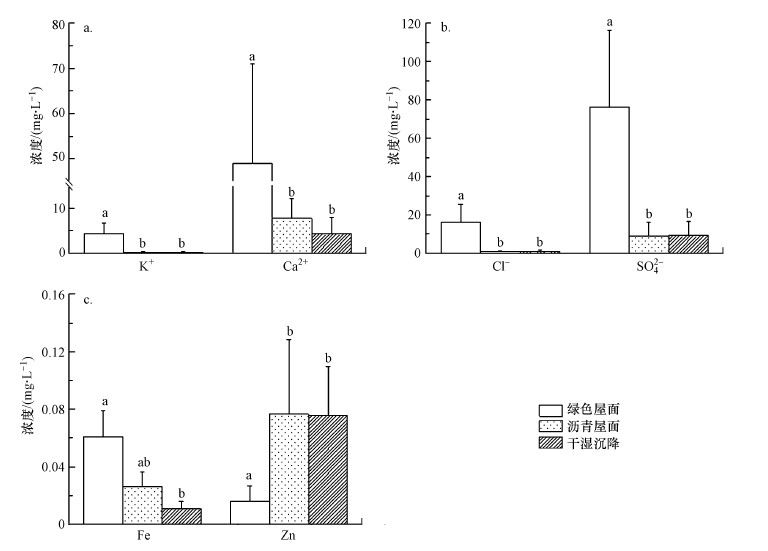 |
| 图 5 绿色屋面、沥青屋面和干湿沉降采样中K+和Ca2+(a), Cl-和SO42+(b), Fe和Zn(c)的平均浓度 Fig. 5The average concentrations of K+ and Ca2+(a), Cl- and SO42+ (b) and Fe and Mn (c) in monitoring rainfall events from the green roof, the asphalt roof, and the rainfall |
3.3 绿色屋面降雨径流水质参数的污染负荷3.3.1 径流水质参数平均污染负荷表 4比较绿色屋面、沥青屋面径流和干湿沉降水质参数的污染负荷发现, 绿色屋面径流中K+、Cl-和SO42-的污染负荷要显著高于沥青屋面和干湿沉降, 因此, 绿色屋面是它们的污染源.然而, 绿色屋面径流中NH4+-N和Zn的污染负荷要显著低于沥青屋面和干湿沉降, 因此, 绿色屋面是它们的汇.此外, 绿色屋面径流TSS的污染负荷要显著低于沥青屋面, 说明绿色屋面对径流中的TSS有一定的净化作用.
表 4(Table 4)
| 表 4 绿色屋面和沥青屋面径流与干湿沉降水质参数污染负荷统计表 Table 4 Comparison of the pollution load of water quality parameters for green roof, asphalt roof and dry and wet deposition | ||||||||||||||||||||||||||||||||||||||||||||||||||||||||||||||||||||||||
表 4 绿色屋面和沥青屋面径流与干湿沉降水质参数污染负荷统计表 Table 4 Comparison of the pollution load of water quality parameters for green roof, asphalt roof and dry and wet deposition
| ||||||||||||||||||||||||||||||||||||||||||||||||||||||||||||||||||||||||
3.3.2 径流水质参数年污染负荷通过比较绿色屋面、沥青屋面径流和干湿沉降水质参数的年污染负荷发现(表 5), 绿色屋面径流TN、NH4+-N、TSS、TIC和Zn的年污染负荷要小于干湿沉降和沥青屋面, 而NO3--N、TOC、K+、Ca2+、Fe、Cl-和SO42-的年污染负荷要大于干湿沉降和沥青屋面.绿色屋面径流COD和TP的年污染负荷要大于干湿沉降但小于沥青屋面.
表 5(Table 5)
| 表 5 绿色屋面和沥青屋面径流与干湿沉降水质参数年污染负荷统计表 Table 5 Comparison of the annual pollution load of water quality parameters for green roof, asphalt roof and dry and wet deposition | ||||||||||||||||||||||||||||||||||||||||||||||||||||||||||||||||||||||||||||||||
表 5 绿色屋面和沥青屋面径流与干湿沉降水质参数年污染负荷统计表 Table 5 Comparison of the annual pollution load of water quality parameters for green roof, asphalt roof and dry and wet deposition
| ||||||||||||||||||||||||||||||||||||||||||||||||||||||||||||||||||||||||||||||||
4 讨论(Discussion)4.1 我国不同地区绿色屋面径流水质的比较影响绿色屋面径流水质的因素主要包括屋面基质组分、基质深度、植物种类、降雨特点、屋面年龄、灌溉水性质、施肥等(Speak et al., 2014; Wang et al., 2017).表 6比较了我国南北方绿色屋面径流水质的差异.由表 6可以看出, 不同地区由于组建绿色屋面基质组分不同, 其径流水质存在较大差异.绿色屋面径流水质最差的是重庆地区的商业基质(珍珠岩、蛭石、泥炭土、锯末), 由于其组建时基质中有机质含量较高(35%), 因此导致其径流水质较差(Dusza et al., 2017).绿色屋面径流水质较好的是成都地区的粉砂粘土基质和重庆地区的沙土基质, 但是这两种基质的质量较重, 要求建筑的承载力较大, 且基质中营养成分较少, 对植物的生长不利, 后期还需施肥管理, 增加了管理成本, 因此, 不易推广应用.与本研究基质最为相似的是重庆地区商业基质(珍珠岩、蛭石、泥炭土、锯末), 种植植物相同, 但是本研究在商业基质中添加了生物炭, 由于生物炭对营养物质(N)和有机污染物具有吸附作用(Beck et al., 2011; Zhang et al., 2019), 因此, 本研究中绿色屋面径流水质要显著好于重庆地区的研究.此外, 石家庄与北京地区气候特点相似, 北京地区的基质也属于轻质商业基质, 种植的植物均为佛甲草, 同样基质中未加入生物炭, 导致其径流水质要明显比本研究差.由此可见, 绿色屋面基质中加入生物炭可以显著减少径流中污染物的排放, 且生物炭价格适中, 可以推广应用.
表 6(Table 6)
| 表 6 我国不同地区绿色屋面径流水质特点 Table 6 Comparison of water quality for the green roof in different areas of China | ||||||||||||||||||||||||||||||||||||||||||||||||||||||||||||||||||||||||||||||||||||||||||||||||||||||||||||||||||
表 6 我国不同地区绿色屋面径流水质特点 Table 6 Comparison of water quality for the green roof in different areas of China
| ||||||||||||||||||||||||||||||||||||||||||||||||||||||||||||||||||||||||||||||||||||||||||||||||||||||||||||||||||
4.2 绿色屋面降雨径流滞留能力的影响因素影响绿色屋面径流滞留能力的因素包括绿色屋面特点(基质层厚度、基质的种类、植物覆盖、绿色屋面年龄、屋面坡度等)和降雨特征(雨前干期、降雨量、空气温度、降雨强度等)(Berndtsson et al., 2010).在这个研究中重点探讨了降雨特征对绿色屋面径流滞留能力的影响.
4.2.1 降雨量对绿色屋面径流滞留能力的影响一般情况下, 降雨量是影响绿色屋面径流滞留率的最重要因素(Zhang et al., 2015).在本研究中, 绿色屋面径流滞留率与降雨量呈现出显著的负相关关系(R2=0.312, p < 0.001) (图 6a), 这与先前的研究结论是一致的(Monterusso et al., 2004).本研究还发现, 绿色屋面最低降雨径流滞留率出现在降雨量较大的月份(7—10月)(图 1), 也证实了这个结果.进一步分析发现, 当降雨量小于10.0 mm时, 绿色屋面可以滞留92%的降雨, 当降雨量达到10.0~24.9 mm时, 绿色屋面可以滞留77%的降雨, 当降雨量为25.0~49.9 mm时, 绿色屋面可以滞留38%的降雨, 当降雨量50.0~99.9 mm时, 绿色屋面可以滞留39%的降雨, 当降雨量大于100 mm时, 绿色屋面可以滞留13%的降雨(图 6b).先前研究也发现随着降雨量的增加, 绿色屋面的径流滞留率逐渐降低(Carter et al., 2006;Simmons et al., 2008).这主要是由于绿色屋面基质对雨水的滞留量是固定的, 当基质达到饱和时, 就不再滞留雨水, 因此, 绿色屋面的径流滞留率与降雨量呈负相关关系.
图 6(Fig. 6)
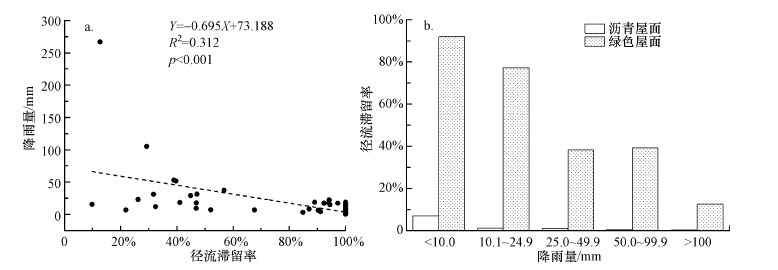 |
| 图 6 绿色屋面径流滞留率与降雨量的相关关系 Fig. 6The relationships between runoff retention and rainfall volume |
4.2.2 雨前干期对绿色屋面径流滞留能力的影响雨前干期决定了基质层能否充分的干燥, 恢复其滞留径流能力(Hathaway et al., 2008), 因此, 雨前干期也是决定绿色屋面径流滞留能力的重要因素(Zhang et al., 2015).但在本研究中发现, 雨前干期与绿色屋面径流滞留率未表现出显著的相关关系.这或许与本研究中小雨事件(降雨量 < 10 mm)较多有关, 当降雨量较小时, 绿色屋面径流滞留能力可能受到雨前干期的影响较小.此外, 在本研究中有场特大暴雨事件(降雨量为266.9 mm), 尽管雨前干期达到了47 h, 但绿色屋面的径流滞留能力仅为12.7%, 这也是导致本研究结论与先前研究存在差异的原因.
图 7(Fig. 7)
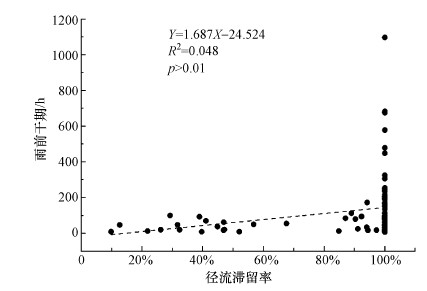 |
| 图 7 绿色屋面径流滞留率与雨前干期的相关关系 Fig. 7The relationships between runoff retention and antecedent dry weather period |
4.2.3 降雨历时对绿色屋面径流滞留能力的影响一般说来, 降雨历时越长, 降雨量相应就会增大, 由于绿色屋面的对降雨径流的滞留能力的固定的, 所以随着降雨历时的延长, 绿色屋面径流滞留率就会降低.本研究发现绿色屋面径流滞留率与降雨历时呈现出显著的负相关关系(R2=0.294, p < 0.01), 这也应正了上述观点(图 8).
图 8(Fig. 8)
 |
| 图 8 绿色屋面径流滞留率与降雨历时的相关关系 Fig. 8The relationships between runoff retention and rainfall duration |
4.3 绿色屋面降雨径流污染来源识别本研究运用主成分分析识别了绿色屋面径流中的主要污染来源.在主成分分析之前, 对数据进行了Kaiser-Meyer-Olkin(KMO)和Bartlett球形检验, KMO值为0.755, Bartlett球形检验值为436.23, 且p < 0.001, 表明原始数据适合进行主成分分析.基于特征根大于1, 识别了绿色屋面径流中4个主成分, 解释了全部变量的77.16%.
由表 7可见, PC1解释了总变量的43.13%, 与PC1密切相关的NH4+-N、TOC、Fe和Zn, 有中等相关关系的指标是COD和TSS.Fe和Zn代表了金属离子污染物, COD和TOC是有机污染物, 在绿色屋面径流中或许主要来自于泥炭土和沥青油毡.先前研究发现, 沥青油毡屋面可以产生大量的有机物, 是有机物的污染来源(Mendez et al., 2011).本研究中绿色屋面的防水层采用的沥青油毡, 当降雨径流流经防水层时, 携带着沥青油毡释放的有机污染物进入径流, 引起绿色屋面径流中有机物浓度的升高.因此, PC1代表了有机物和重金属的污染源.
表 7(Table 7)
| 表 7 绿色屋面主成分分析结果 Table 7 Principal component analysis of different contents in the water of the green roof | |||||||||||||||||||||||||||||||||||||||||||||||||||||||||||||||||||||||||||||||||||||||||||||||||||
表 7 绿色屋面主成分分析结果 Table 7 Principal component analysis of different contents in the water of the green roof
| |||||||||||||||||||||||||||||||||||||||||||||||||||||||||||||||||||||||||||||||||||||||||||||||||||
PC2解释了总变量的15.93%, 与PC2有显著正相关关系的指标是Ca2+、Cl-、SO42-和EC.研究发现, 绿色屋面径流中Ca2+、Cl-和SO42-主要来自于绿色屋面基质(Vijayaraghavan et al., 2012).在本研究中, 绿色屋面径流中的EC、Ca2+、Cl-和SO42-的浓度要显著高于沥青屋面和干湿沉降, 因此, 这些离子主要来自于绿色屋面基质(泥炭土和蛭石).所以, PC2代表了离子污染源(泥炭土和蛭石).
PC3解释了总变量的10.18%, 与PC3有显著正相关关系的指标是pH.绿色屋面径流中pH受到绿色屋面基质物理化学特点的综合影响, 因此PC3代表了物化污染源.
PC4解释了总变量的7.92%, 与PC4有显著正相关关系的指标是NO3--N和TN.NO3--N和TN主要代表了营养物质, 并且主要来自于绿色屋面基质中的泥炭土.研究发现绿色屋面径流中的氮主要来自于屋面基质层和屋面的维护(屋面施肥)(Berndtsson et al., 2010).在这个研究中, 绿色屋面径流中NO3--N和TN的浓度要高于沥青屋面和干湿沉降, 并且绿色屋面未进行施肥.因此, 绿色屋面径流中的NO3--N和TN主要来自于屋面基质层(如泥炭土), 并且大气干湿沉降也有一定的贡献.所以, PC4主要代表了营养物质污染源.
5 结论(Conclusions)1) 绿色屋面具有很好的径流滞留效果, 平均径流滞留率达到53.4%.绿色屋面径流滞留率月变化受到降雨量的显著影响, 表现为在丰水期径流滞留率要小于枯水期, 此外绿色屋面降雨径流滞留率受到降雨历时的显著影响.
2) 基于径流水质, 绿色屋面显著增加了径流中EC、COD、TOC、K+、Ca2+、Cl-和SO42-的浓度, 是它们的污染源, 但显著降低了径流中NH4+-N和Zn的浓度, 是它们的汇.
3) 基于污染负荷, 绿色屋面是K+、Cl-和SO42-的污染源, 是NH4+-N和Zn的汇;绿色屋面径流TN、NH4+-N、TSS、TIC和Zn的年污染负荷要小于干湿沉降和沥青屋面, 而NO3--N、TOC、K+、Ca2+、Fe、Cl-和SO42-的年污染负荷要大于干湿沉降和沥青屋面.
4) 绿色屋面存在4类污染源, 即有机物和重金属源(来自于泥炭土和沥青油毡), 离子污染源(来自于泥炭土和蛭石), 物化污染源和营养物质污染源(来自于泥炭土和大气沉降).
参考文献
| Aitkenhead-Peterson J A, Dvorak B D, Volder A, et al. 2011. Chemistry of growth medium and leachate from green roof systems in south-central Texas[J]. Urban Ecosystems, 14(1): 17-33. DOI:10.1007/s11252-010-0137-4 |
| Alsup S, Ebbs S, Retzlaff W. 2010. The exchangeability and leachability of metals from select green roof growth substrates[J]. Urban Ecosystems, 13: 91-111. DOI:10.1007/s11252-009-0106-y |
| Beck D A, Johnson G R, Spolek G A. 2011. Amending greenroof soil with biochar to affect runoff water quantity and quality[J]. Environmental Pollution, 159(8/9): 2111-2118. |
| Benvenuti S. 2014. Wildflower green roofs for urban landscaping, ecological sustainability and biodiversity[J]. Landscape & Urban Planning, 124(4): 151-161. |
| Berndtsson J C. 2010. Green roof performance towards management of runoff water quantity and quality: A review[J]. Ecological Engineering, 36(4): 351-360. DOI:10.1016/j.ecoleng.2009.12.014 |
| Berndtsson J C, Bengtsson L, Jinno K. 2009. Runoff water quality from intensive and extensive vegetated roofs[J]. Ecological Engineering, 35(3): 369-380. DOI:10.1016/j.ecoleng.2008.09.020 |
| Carpenter C M, Todorov D, Driscoll C T, et al. 2016. Water quantity and quality response of a green roof to storm events: Experimental and monitoring observations[J]. Environmental Pollution, 218: 664-672. DOI:10.1016/j.envpol.2016.07.056 |
| Carter T L, Rasmussen T C. 2006. Hydrologic behavior of vegetated roof S1. Journal of the American[J]. Water Resources Association, 42(5): 1261-1274. DOI:10.1111/j.1752-1688.2006.tb05611.x |
| Chen C F. 2013. Performance evaluation and development strategies for green roofs in Taiwan: A review[J]. Ecological Engineering, 52: 51-58. DOI:10.1016/j.ecoleng.2012.12.083 |
| Cipolla S S, Maglionico M, Stojkov I. 2016. A long-term hydrological modelling of an extensive green roof by means of SWMM[J]. Ecological Engineering, 95: 876-887. DOI:10.1016/j.ecoleng.2016.07.009 |
| Connelly M, Hodgson M. 2013. Experimental investigation of the sound transmission of vegetated roofs[J]. Applied Acoustics, 74(10): 1136-1143. DOI:10.1016/j.apacoust.2013.04.003 |
| Dusza Y, Barot S, Kraepiel Y, et al. 2017. Multifunctionality is affected by interactions between green roof plant species, substrate depth, and substrate type[J]. Ecology and Evolution, 7(7): 2357-2369. DOI:10.1002/ece3.2691 |
| Gong Y W, Zhang X W, Li J Q, et al. 2020. Factors affecting the ability of extensive green roofs to reduce nutrient pollutants in rainfall runoff[J]. Science of the Total Environment, 732: 139248. DOI:10.1016/j.scitotenv.2020.139248 |
| 国家环境保护总局. 2002. 地表水环境质量标准(GB 3838-2002)[S]. 北京: 中国环境科学出版社 |
| 国家环境保护总局《水和废水监测分析方法》编委会. 2002. 水和废水监测分析方法[M]. 北京: 中国环境科学出版社. |
| Hao N, Corrie C, Jiti Z, et al. 2010. Scaling of economic benefits from green roof implementation in Washington, DC[J]. Environmental Science & Technology, 44(11): 4302-4308. |
| Harper G E, Limmer M A, Showalter W E, et al. 2015. Nine-month evaluation of runoff quality and quantity from an experiential green roof in Missouri, USA[J]. Ecological Engineering, 78: 127-133. DOI:10.1016/j.ecoleng.2014.06.004 |
| Hathaway A, Hunt W F, Jennings G. 2008. A field study of green roof hydrologic and water quality performance[J]. Trans. ASABE, 51(1): 37-43. DOI:10.13031/2013.24225 |
| Mendez C B, Klenzendorf J B, Afshar B R, et al. 2011. The effect of roofing material on the quality of harvested rainwater[J]. Water Research, 45(5): 2049-2059. DOI:10.1016/j.watres.2010.12.015 |
| Monterusso M A, Rowe D B, Russell D K, et al. 2004. Runoff water quantity and quality from green roof systerns[J]. Acta Horticuhurae, 639: 369-376. |
| Nawaz R, McDonald A, Postoyko S. 2015. Hydrological performance of a full-scale extensive green roof located in a temperate climate[J]. Ecological Engineering, 82: 66-80. DOI:10.1016/j.ecoleng.2014.11.061 |
| Razzaghmanesh M, Beecham S, Salemi T. 2016. The role of green roofs in mitigating Urban Heat Island effects in the metropolitan area of Adelaide, South Australia[J]. Urban Forestry & Urban Greening, 15: 89-102. |
| Seidl M, Gromaire M C, Saad M, et al. 2013. Effect of substrate depth and rain-event history on the pollutant abatement of green roofs[J]. Environmental Pollution, 183: 195-203. DOI:10.1016/j.envpol.2013.05.026 |
| Skala V, Dohnal M, Votrubova J T, et al. 2020. Hydrological and thermal regime of a thin green roof system evaluated by physically-based model[J]. Urban Forestry & Urban Greening, 48: 126582. |
| Simmons M T, Gardiner B, Windhager S, et al. 2008. Green roofs are not created equal: The hydrologic and thermal performance of six different extensive green roofs and reflective and non-reflective roofs in a sub-tropical climate[J]. Urban Ecosystem, 11: 339-348. DOI:10.1007/s11252-008-0069-4 |
| Song P, Huang G, An C, et al. 2019. Performance analysis and life cycle greenhouse gas emission assessment of an integrated gravitational-flow wastewater treatment system for rural areas[J]. Environmental Science and Pollution Research, 26: 25883-25897. DOI:10.1007/s11356-019-05746-2 |
| Speak A F, Rothwell J J, Lindley S J, et al. 2014. Metal and nutrient dynamics on an aged intensive green roof[J]. Environmental Pollution, 184: 33-43. DOI:10.1016/j.envpol.2013.08.017 |
| Todorov D, Driscoll C T, Todorova S, et al. 2018. Water quality function of an extensive vegetated roof[J]. Science of the Total Environment, 625: 928-939. DOI:10.1016/j.scitotenv.2017.12.085 |
| Vijayaraghavan K, Joshi U M, Balasubramanian R. 2012. A field study to evaluate runoff quality from green roofs[J]. Water research, 46(4): 1337-1345. DOI:10.1016/j.watres.2011.12.050 |
| Wang H, Qin J, Hu Y. 2017. Are green roofs a source or sink of runoff pollutants[J]. Ecological Engineering, 107: 65-70. DOI:10.1016/j.ecoleng.2017.06.035 |
| 王书敏, 于慧, 张彬, 等. 2011. 绿色屋顶技术控制城市面源污染应用研究进展[J]. 重庆文理学院学报(自然科学版), 30(4): 59-64. DOI:10.3969/j.issn.1673-8012.2011.04.014 |
| 王书敏, 何强, 张峻华, 等. 2012. 绿色屋顶径流氮磷浓度分布及赋存形态[J]. 生态学报, 32(12): 3691-3700. |
| Zhang Q, Miao L, Wang X, et al. 2015. The capacity of greening roof to reduce stormwater runoff and pollution[J]. Landscape & Urban Planning, 144(1): 142-150. |
| Zhang Q Q, Miao L P, Wang H W, et al. 2019. Analysis of the effect of green roof substrate amended with biochar on water quality and quantity of rainfall runoff[J]. Environmental Monitoring and Assessment, 191(5): 304-314. DOI:10.1007/s10661-019-7466-4 |
| 张千千, 王效科, 高勇, 等. 2015. 绿色屋面降雨径流水质及消减污染负荷的研究[J]. 生态学报, 35(10): 3454-3463. |
| 郑美芳, 邓云, 刘瑞芬, 等. 2013. 绿色屋顶屋面径流水量水质影响实验研究[J]. 浙江大学学报(工学版), 47(10): 1846-1851. |
